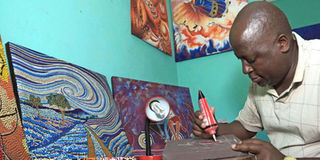Lecturer who uses discarded lollipop sticks to create art

Patrick Ng'ang'a at work in his house in Nyeri on November 29, 2018. PHOTO | JOSEPH KANYI
What you need to know:
- He started experimenting in art as a child at home and school, and only got interested in it as a career post high school.
- To complement his passion, he bought art and design books for studies and started going the gallery exhibitions.
Take a single glance at Patrick Ng’ang’a's pieces of art and you will be tempted to touch and feel the texture of the images that form an intriguing pattern.
Before grasping the message being conveyed in the paintings, his clients have to work through the dotted images to understand the literal art that he explains in a playful manner.
At the Kamwenja Teachers Training College in Nyeri, Ng’ang’a, who is a fine arts lecturer, collects dumped lollipop sticks in the compound that he later uses to artistically express himself.
He uses dotillism technique to express himself on the Kenyan way of living ranging from love, environment, diverse cultures, politics and abstracts, among others.
Dotillism, Ng’ang’a explains, was part of the thesis that he presented while undertaking his Master’s degree in Fine Arts at the University of Nairobi, having completed his Bachelors in Education (Fine Arts) at the Kenyatta University in 2003.
“I had the idea of using dots using a brush, oils and even earbuds, but it did not work. I resorted to using straws, but the dots were too big and used up too much paint, but I still completed the project though it did not match my concept,” he says.
To fine tune the dotillism technique, he says he collected a lollipop stick in the compound and fixed it on the acrylic paint tubes using a masking tape, which controlled the colours and size of the dots.
Ng’ang’a says he started experimenting in art as a child at home and school, and only got interested in it as a career post high school.
“I started drawing while in primary school. I used to carve stones and wood as a pass time. I did not know it would get me here,” he said.
MOTIVATION
To complement his passion, he bought art and design books for studies and started going the gallery exhibitions.
“I did a crayon etching and carried it to the Watatu Workshop that was active in the ‘90s. I sold it for Sh5,000,” said Mr Ng’ang’a. He later joined Kuona Trust.
“Through the interactions I got to fine tune my art in painting,” said Mr Ng’ang’a.
He says he draws his motivation from everyday happenings in the communities and uses the diversity in all the tribes to create images that relate with them.
His paintings cost from Sh5,000 and above, depending on who is buying.
“To place a price tag in a painting, I consider its size and value of that gem,” he says.
Though he has struggled to build a client base, he points out that corporates and individuals are appreciating well done and unique art pieces irrespective of the price tag.
“There is a very negative attitude toward Kenyan art and a lot of ignorance,” Ng’ang’a says, adding that it takes a lot of effort to convince people to purchase an art piece.
“Art is very subjective and a client has to like it enough to actually pay for it,” he notes.
He has so far sold his paintings to clients in Germany, Britain, Taiwan and France and he also exhibits at the Kenya art fair in Nairobi, the Nairobi museum, group exhibitions and international art shows.
The paintings can take between two to three days to complete. He uses wood, canvases, primers or emulsion paints that are used to treat the canvas.
“The main challenge I have encountered is patenting my artwork since I am required to patent every piece, which is very expensive,” he said.
He also says prices for the painting materials have risen steeply.





